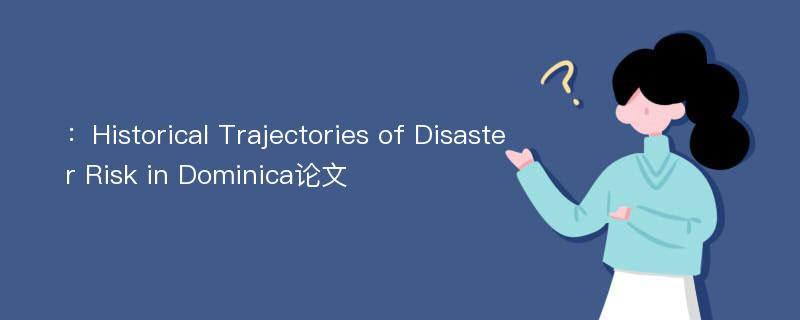
本文主要研究内容
作者(2019)在《Historical Trajectories of Disaster Risk in Dominica》一文中研究指出:The calamitous consequences of 2017 Hurricane Maria for the Caribbean island of Dominica highlighted the acute and increasing susceptibility of the region to disasters. Despite increasing international attention to disaster risk reduction, recovery from hazard events can be especially lengthy and difficult for small island developing states. In this article, we build on existing understandings of disaster risk as a physical and social condition, showing that historical processes are fundamental to understanding how conditions of risk emerge and persist over time. We take an integrated approach to analyzing the drivers of risk accumulation, using the example of Dominica, where processes set in motion during the colonial period have shaped the location of people and assets, the degree to which they might be harmed, the societal repercussions of that harm and the prospects for recovery. We focus on the underlying economic vulnerabilities and physical exposure to hazards created by agricultural, economic, and social practices, and successive disaster responses that have constrained recovery. Uncovering these historical drivers and persistent issues, elucidates lessons for pursuing a more resilient development trajectory, including through the promotion of economic restructuring and diversification, and land reform.
Abstract
The calamitous consequences of 2017 Hurricane Maria for the Caribbean island of Dominica highlighted the acute and increasing susceptibility of the region to disasters. Despite increasing international attention to disaster risk reduction, recovery from hazard events can be especially lengthy and difficult for small island developing states. In this article, we build on existing understandings of disaster risk as a physical and social condition, showing that historical processes are fundamental to understanding how conditions of risk emerge and persist over time. We take an integrated approach to analyzing the drivers of risk accumulation, using the example of Dominica, where processes set in motion during the colonial period have shaped the location of people and assets, the degree to which they might be harmed, the societal repercussions of that harm and the prospects for recovery. We focus on the underlying economic vulnerabilities and physical exposure to hazards created by agricultural, economic, and social practices, and successive disaster responses that have constrained recovery. Uncovering these historical drivers and persistent issues, elucidates lessons for pursuing a more resilient development trajectory, including through the promotion of economic restructuring and diversification, and land reform.
论文参考文献
论文详细介绍
论文作者分别是来自International Journal of Disaster Risk Science的,发表于刊物International Journal of Disaster Risk Science2019年02期论文,是一篇关于,International Journal of Disaster Risk Science2019年02期论文的文章。本文可供学术参考使用,各位学者可以免费参考阅读下载,文章观点不代表本站观点,资料来自International Journal of Disaster Risk Science2019年02期论文网站,若本站收录的文献无意侵犯了您的著作版权,请联系我们删除。
标签:International Journal of Disaster Risk Science2019年02期论文;
